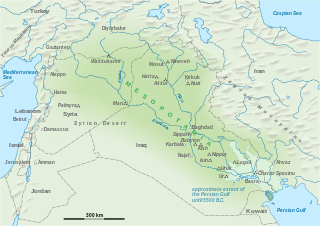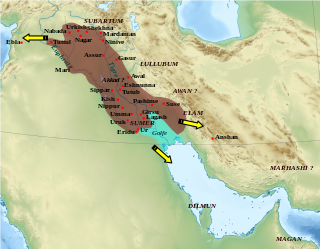External links
Kings of Isin-Larsa | |
|---|---|
| Isin 1953-1730 BCE (ST) | |
| Larsa 1940-1674 BCE (ST) | |
| | This Middle Eastern biographical article is a stub. You can help Wikipedia by expanding it. |
Zabaia (or Zabaya) ruled the ancient Near East city-state of Larsa from 1941 BC to 1932 BC (MC). He was an Amorite and the son of Samium. [1] [2] [3] [4]
A brick inscription found at Larsa reads, "Zabaya, Chief of the Amorites, son of Samium, re-built the Ebabbar" (Zabaya rabian Amurri mar Samium Ebabbara ipus). The E-babbar is a temple of the god Shamash. An alternate reading is the he "built" the Ebabbar". [5] This is the only known textual mention of Samium outside the Larsa King List. [6] [7] A damaged clay cone found at Mashkan-shapir carries a similar text. [8] Larsa ruler Abisare also used the "Chief of the Amorites" title. [9]

Larsa, also referred to as Larancha/Laranchon by Berossos and connected with the biblical Ellasar, was an important city-state of ancient Sumer, the center of the cult of the sun god Utu with his temple E-babbar. It lies some 25 km (16 mi) southeast of Uruk in Iraq's Dhi Qar Governorate, near the east bank of the Shatt-en-Nil canal at the site of the modern settlement Tell as-Senkereh or Sankarah.

The Old Babylonian Empire, or First Babylonian Empire, is dated to c. 1894–1595 BC, and comes after the end of Sumerian power with the destruction of the Third Dynasty of Ur, and the subsequent Isin-Larsa period. The chronology of the first dynasty of Babylonia is debated; there is a Babylonian King List A and also a Babylonian King List B, with generally longer regnal lengths. In this chronology, the regnal years of List A are used due to their wide usage.
Isin (Sumerian: 𒉌𒋛𒅔𒆠, romanized: I3-si-inki, modern Arabic: Ishan al-Bahriyat) is an archaeological site in Al-Qādisiyyah Governorate, Iraq which was the location of the Ancient Near East city of Isin, occupied from the late 4th millennium Uruk period up until at least the late 1st millennium BC Neo-Babylonian period. It lies about 40 km (25 mi) southeast of the modern city of Al Diwaniyah.

Sin-Muballit was the father of Hammurabi and the fifth Amorite king of the first dynasty of Babylonia, reigning c. 1813-1792 or 1748-1729 BC. He ruled over a relatively new and minor kingdom; however, he was the first ruler of Babylon to actually declare himself king of the city, and the first to expand the territory ruled by the city, and his son greatly expanded the Babylonian kingdom into the short lived Babylonian Empire.
Adab was an ancient Sumerian city between Girsu and Nippur, lying about 35 kilometers southeast of the latter. It was located at the site of modern Bismaya or Bismya in the Al-Qādisiyyah Governorate of Iraq. The site was occupied at least as early as the 3rd Millenium BC, through the Early Dynastic, Akkadian Empire, and Ur III empire periods, into the Kassite period in the mid-2nd millennium BC. It is known that there were temples of Ninhursag/Digirmah, Iskur, Asgi, Inanna and Enki at Adab and that the city-god of Adab was Parag'ellilegarra (Panigingarra) "The Sovereign Appointed by Ellil".

Samsu-iluna was the seventh king of the founding Amorite dynasty of Babylon. His reign is estimated from 1749 BC to 1712 BC, or from 1686 to 1648 BC. He was the son and successor of Hammurabi by an unknown mother. His reign was marked by the violent uprisings of areas conquered by his father and the abandonment of several important cities.

The Third Dynasty of Ur or Ur III was a Sumerian dynasty based in the city of Ur in the 22nd and 21st centuries BC. For a short period they were the preeminent power in Mesopotamia and their realm is sometimes referred to by historians as the Neo-Sumerian Empire.

The Civilization of Mesopotamia ranges from the earliest human occupation in the Paleolithic period up to Late antiquity. This history is pieced together from evidence retrieved from archaeological excavations and, after the introduction of writing in the late 4th millennium BC, an increasing amount of historical sources. While in the Paleolithic and early Neolithic periods only parts of Upper Mesopotamia were occupied, the southern alluvium was settled during the late Neolithic period. Mesopotamia has been home to many of the oldest major civilizations, entering history from the Early Bronze Age, for which reason it is often called a cradle of civilization.
The Dynasty of Isin refers to the final ruling dynasty listed on the Sumerian King List (SKL). The list of the Kings of Isin with the length of their reigns, also appears on a cuneiform document listing the kings of Ur and Isin, the List of Reigns of Kings of Ur and Isin.
Kazalla or Kazallu (Ka-zal-luki) is the name given in Akkadian sources to a city in the ancient Near East whose locations is unknown. Its god is Numushda with his consort Namrat. There are indications that the god Lugal-awak also lived in Kazallu.
Tell al-Lahm is an archaeological site in Dhi Qar Governorate (Iraq). It is 38 km (24 mi) southeast of the site of ancient Ur. Its ancient name is not known with certainty with Kuara, Kisig, and Dur-Iakin having been proposed. The Euphrates River is 256 km (159 mi) away but in antiquity, or a branch of it, ran by the site, continuing to flow until the Muslim Era.

Naplanum was the first independent king of the ancient Near Eastern city-state of Larsa c. 2025 BC – 2004 BC (MC) — roughly during the reign of Ibbi-Sin of the Third dynasty of Ur and the great famine — according to the later Larsa King List. No contemporary year names or inscriptions have been found verifying that Naplanum was a king of Larsa, which seems to have remained part of Ibbi-Sin's kingdom. However a prominent and wealthy Amorite merchant named Naplanum does appear in many sales records of the grain industry during these later days of the Third Dynasty, who may well have been the ancestor of the later independent kings of Larsa.

Sin-Iddinam ruled the ancient Near East city-state of Larsa from 1849-1843 BC (MC). He was the son of Nur-Adad, with whom there may have been a short co-regency overlap.
Mashkan-shapir was an ancient tell roughly 30 kilometres (19 mi) north of Nippur and around 90 miles (140 km) southeast of Baghdad. The city god of Mashkan-shapir was Nergal and a temple named Meslam dedicated to him was built there. It is about 20 kilometers south of ancient Malgium. The remnants of a large watercourse, thought to be an ancient bed of the Tigris or Euphrates, pass close to the city.

Sîn-kāšid was the king of the ancient Mesopotamian city of Uruk during the first half of the 18th century BC. His precise dating is uncertain, perhaps ca. 1803–1770 BC corresponding to ca.1865–1833 BC, but likely to have been fairly long due to the voluminous building inscriptions extant for which he is best known and contemporary with Nur-Adad of Larsa and Enlil-bāni of Isin. His apparent lack of relationship with any of the preceding rulers of Uruk and his omission of mentioning his father in any of his inscriptions has led to the belief that he was the founder of a dynasty. He participated in a diplomatic marriage with Šallurtum, the daughter of Sūmû-la-Il, the second king of the First Babylonian Dynasty, as her name and epithets appear in the seal impressions of three clay bullae recovered from the remains of his palace.

Akkad was the capital of the Akkadian Empire, which was the dominant political force in Mesopotamia during a period of about 150 years in the last third of the 3rd millennium BC.

The Amorites were an ancient Northwest Semitic-speaking Bronze Age people from the Levant. Initially appearing in Sumerian records c. 2500 BC, they expanded and ruled most of the Levant, Mesopotamia and parts of Egypt from the 21st century BC to the late 17th century BC.

The Sukkalmah or Epartid dynasty, was an early dynasty of West Asia in the ancient region of Elam, to the southeast of Babylonia. It corresponds to the third Paleo-Elamite period. The Sukkalmah dynasty followed the Shimashki dynasty. The title of Sukkalmah means "Grand Regent" and was used by some Elamite rulers. Numerous cuneiform documents and inscriptions remain from this period, particularly from the area of Susa, making the Sukkalmah period one of the best documented in Elamite history.
The Isin-Larsa period is a phase in the history of ancient Mesopotamia, which extends between the end of the Third Dynasty of Ur and the conquest of Mesopotamia by King Hammurabi of Babylon leading to the creation of the First Babylonian dynasty. According to the approximate conventional dating, this period begins in 2025 BCE and ended in 1763 BCE. It constitutes the first part of the Old Babylonian period, the second part being the period of domination of the first dynasty of Babylon, which ends with the Sack of Babylon in 1595 BCE and the rise of the Kassites.
The Manana Dynasty ruled over an ancient Near East state in Mesopotamia during Isin-Larsa period in the chaotic time after the fall of the Ur III Empire. In the power vacumn, Mesopotamia became a struggle for power between city-states, some like Isin, Larsa, and later Babylon would rise while others, like the state ruled by the Manana Dynasty, faded from history.